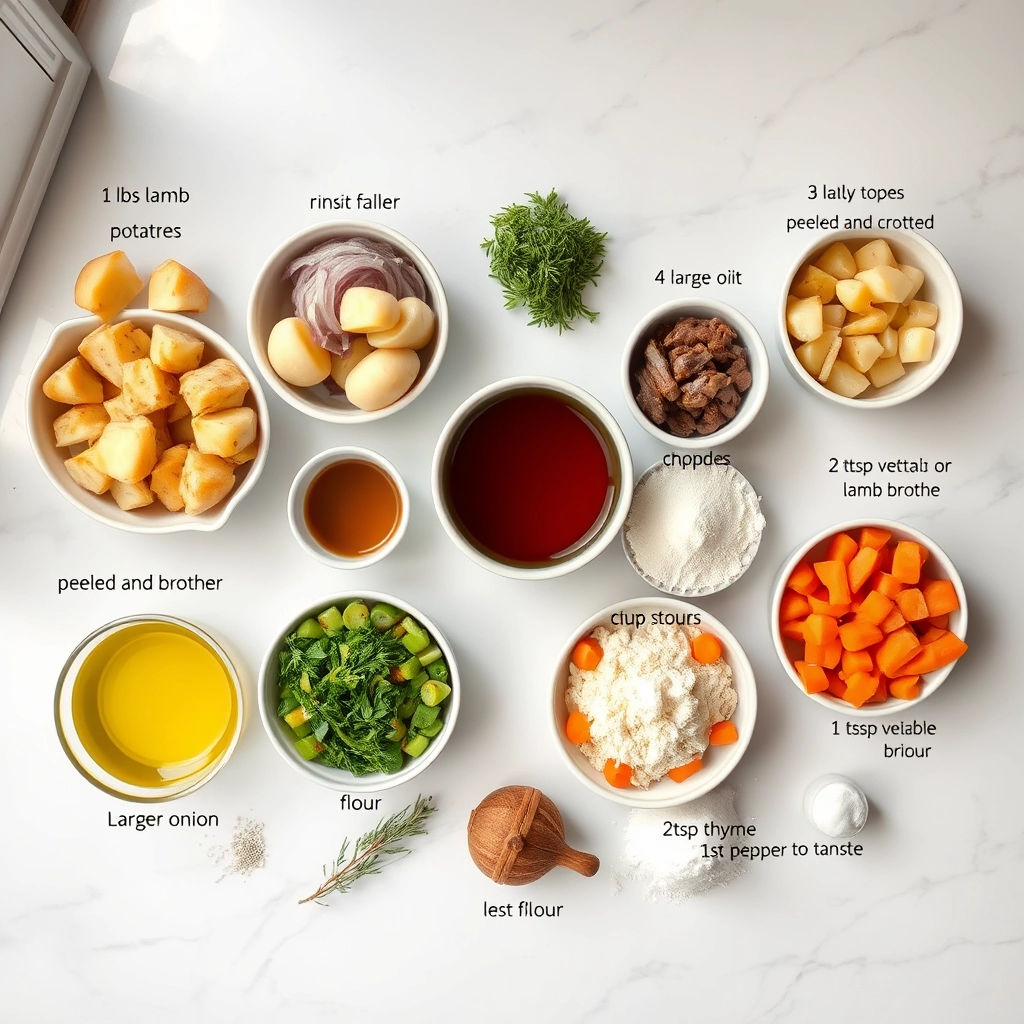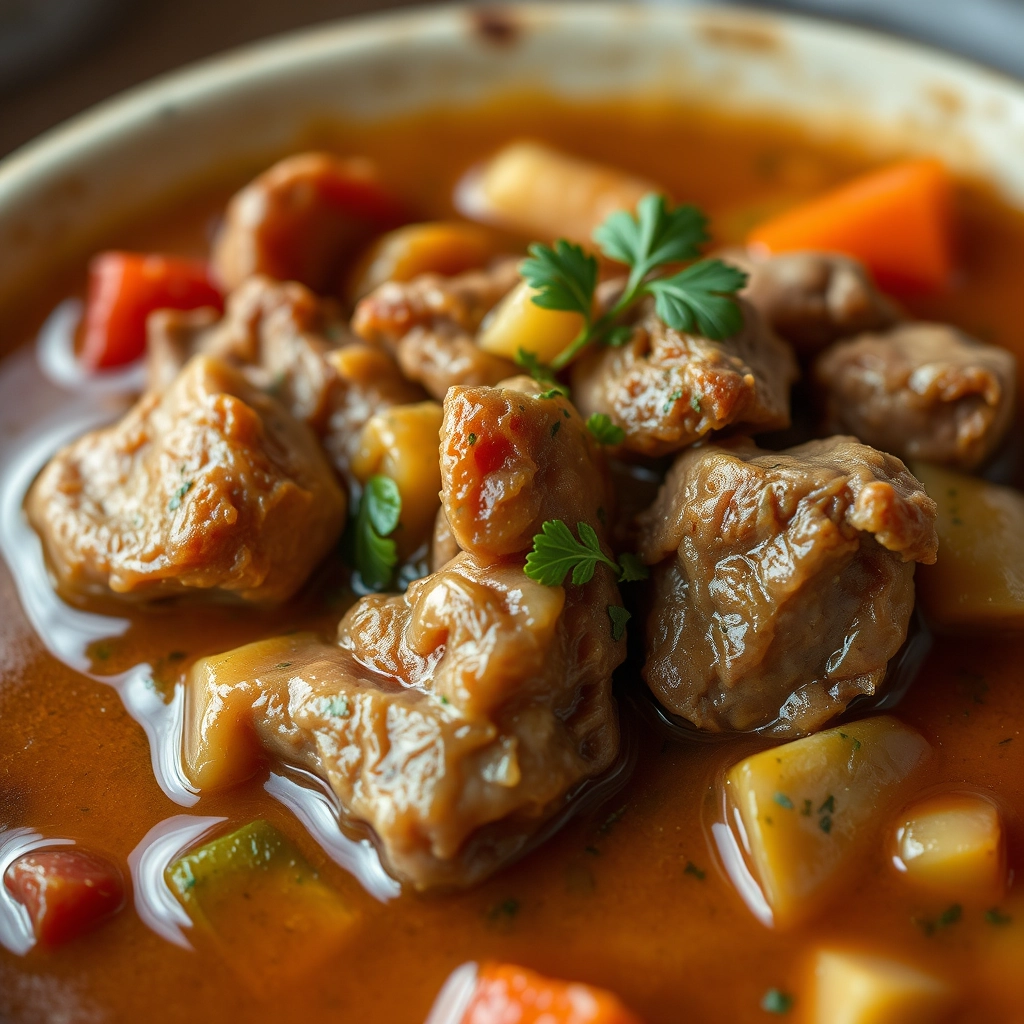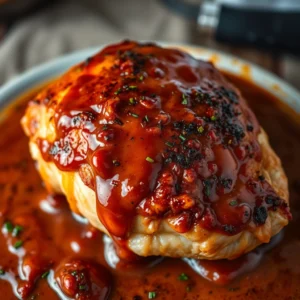There’s something about a pot of Irish stew simmering on the stove that feels like a warm hug on a chilly evening. I remember my first taste of authentic Irish stew during a misty afternoon in County Kerry, where the scent of lamb and herbs seemed to weave through the very cobblestones. That rich, comforting bowl inspired me to recreate the magic at home—and after many trials (and a few happy accidents), this recipe has become my go-to when I crave something deeply nourishing and soul-satisfying.
Ingredients You’ll Need
Gathering simple, quality ingredients is the secret to this stew’s rustic charm. Here’s what you’ll need:
- 2 lbs lamb shoulder (cut into chunks) – The star of the show! Look for well-marbled meat for maximum tenderness.
- 4 large potatoes (russets or Yukon Golds) – They’ll break down slightly to thicken the broth.
- 3 carrots (chopped into coins) – For that sweet, earthy balance.
- 1 large onion (roughly chopped) – A humble base that adds depth.
- 4 cups beef or lamb stock – Homemade if possible, but a good-quality store-bought works too.
- 2 tbsp flour – To coat the lamb for that perfect sear.
- 1 tsp fresh thyme (or ½ tsp dried) – A whisper of herbal warmth.
- 1 bay leaf – Don’t skip this! It’s the quiet background note that ties everything together.
- Salt & black pepper – To taste. Be generous!
- A splash of Guinness (optional) – For a deeper, malty richness (my little twist!).
Step-by-Step Instructions
This stew is forgiving, but a few key steps make all the difference:
- Brown the lamb: Toss the lamb chunks in flour seasoned with salt and pepper. In a heavy pot (I adore my enameled cast iron for this), sear the meat in batches until golden. Don’t rush this step—those crispy bits add incredible flavor!
- Sweat the onions: In the same pot, soften the onions until translucent, scraping up any browned bits from the lamb. This is where the magic starts!
- Layer the goodness: Return the lamb to the pot, add carrots, potatoes, thyme, and bay leaf. Pour in the stock (and Guinness, if using) until everything is just submerged.
- Simmer low and slow: Cover and let it bubble gently for 1.5–2 hours. Peek occasionally—the stew is ready when the lamb falls apart at a glance and the potatoes have thickened the broth.
- Season & serve: Fish out the bay leaf, adjust salt and pepper, and ladle into bowls. A sprinkle of fresh parsley is lovely here!
Tip: If the broth seems thin, mash a few potatoes against the pot’s side to thicken it naturally. And always let the stew rest for 10 minutes off the heat—it lets the flavors settle beautifully.

There’s something deeply comforting about a bowl of classic Irish stew—tender chunks of meat, hearty root vegetables, and a rich, savory broth that warms you from the inside out. Whether you’re celebrating St. Patrick’s Day or just craving a cozy meal, this recipe is a timeless favorite.
Pro Tips, Variations, and Substitutions
To make your Irish stew truly shine, keep these tips in mind:
- Choose the right cut of meat: Lamb shoulder is traditional, but beef chuck or stew meat works well too. Just make sure it has some marbling for tenderness.
- Brown the meat first: Don’t skip searing the meat—it adds incredible depth of flavor.
- Use Guinness for depth: A splash of dark beer enriches the broth, but you can substitute with beef stock if preferred.
- Vegetable swaps: No parsnips? Carrots or turnips make great alternatives. Add cabbage for extra heartiness.
- Make it ahead: Like many stews, this tastes even better the next day as the flavors meld.
What to Serve with Irish Stew
This stew is a meal in itself, but a few accompaniments make it even better:
- Soda bread: A slice of warm, buttered Irish soda bread is perfect for soaking up the broth.
- Mashed potatoes: For extra comfort, serve with a dollop of creamy mashed potatoes.
- Pickled vegetables: A tangy side of pickled beets or onions cuts through the richness.
- A pint of Guinness: Because why not keep the Irish theme going?
Storage and Reheating Tips
This stew keeps beautifully, making it great for meal prep or leftovers:
- Refrigerate: Store in an airtight container for up to 4 days.
- Freeze: Portion into freezer-safe containers and freeze for up to 3 months. Thaw overnight in the fridge before reheating.
- Reheat gently: Warm on the stovetop over low heat, stirring occasionally. Add a splash of broth if needed to loosen the stew.
Frequently Asked Questions
Can I make this stew in a slow cooker?
Absolutely! After browning the meat, transfer everything to a slow cooker and cook on low for 6–8 hours or high for 3–4 hours.
Is Irish stew gluten-free?
Yes, as long as you skip the Guinness (or use a gluten-free beer) and thicken with cornstarch instead of flour.
Can I use lamb chops instead of stew meat?
While possible, chops can become tough with long cooking. Stick to shoulder or leg cuts for the best texture.
Why is my stew too thin?
Let it simmer uncovered for a bit longer to reduce, or mix a tablespoon of flour with cold water and stir it in to thicken.
There you have it—a bowl of Irish stew that’s as nourishing as it is delicious. Whether shared with loved ones or savored solo, this dish is a little taste of Ireland’s warmth and hospitality. Sláinte!
PrintIrish Stew
A hearty and traditional Irish stew made with tender lamb, potatoes, and carrots, simmered in a rich broth.
Ingredients
For the Crust:
- 1.5 lbs lamb shoulder, cut into chunks
- 4 large potatoes, peeled and quartered
- 3 large carrots, peeled and sliced
- 1 large onion, chopped
- 4 cups beef or lamb broth
- 2 tbsp flour
- 2 tbsp vegetable oil
- 1 tsp thyme
- 1 tsp rosemary
- Salt and pepper to taste
Instructions
1. Prepare the Crust:
- Heat oil in a large pot over medium heat. Add lamb and brown on all sides. Remove and set aside.
- In the same pot, sauté onions until soft. Sprinkle flour over onions and stir to combine.
- Return lamb to the pot. Add broth, potatoes, carrots, thyme, rosemary, salt, and pepper.
- Bring to a boil, then reduce heat to low. Cover and simmer for 1.5 to 2 hours, until lamb is tender.
- Adjust seasoning if needed and serve hot.
Notes
You can customize the seasonings to taste.



